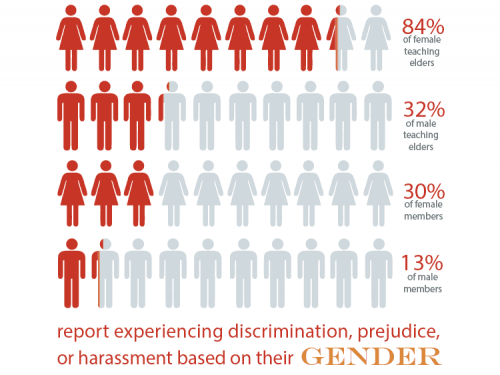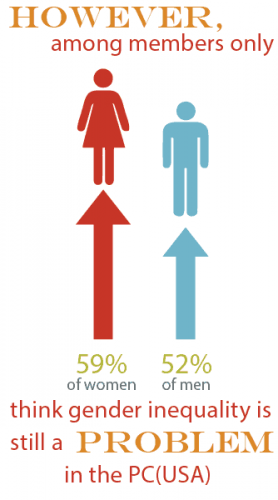Women’s Advocacy Day observed at the Presbyterian Center
by Gail Strange | Presbyterian News Service
 Last Wednesday started, as most do at the Presbyterian Center, with a 9:00 a.m. worship service. But this service was unique. Staff and guests gathered for a Service of Awareness sponsored jointly by Presbyterian Women and the Racial Ethnic & Women’s Ministries that focused on gender-based violence—intimate partner violence, sexual assault, and human trafficking. Instead of a traditional sermon, worshipers heard stories of fear and isolation belonging to women who had suffered abuse at the hands of men who told them, “I love you.”
Last Wednesday started, as most do at the Presbyterian Center, with a 9:00 a.m. worship service. But this service was unique. Staff and guests gathered for a Service of Awareness sponsored jointly by Presbyterian Women and the Racial Ethnic & Women’s Ministries that focused on gender-based violence—intimate partner violence, sexual assault, and human trafficking. Instead of a traditional sermon, worshipers heard stories of fear and isolation belonging to women who had suffered abuse at the hands of men who told them, “I love you.”
The powerful morning worship service was the first event of a day set aside as Women’s Advocacy Day at the Presbyterian Center in observance of Domestic Violence Awareness Month. Employees were also invited to attend a lunchtime “Conversation with Allies” with representatives from the Kentucky Coalition Against Domestic Violence and the Louisville Coalition for the Convention on the Elimination of Discrimination against Women (CEDAW).
CEDAW, adopted in 1979 by the UN General Assembly, is often described as an international bill of rights for women. It defines what constitutes discrimination against women and sets up an agenda for national action to end this discrimination.
The findings from the Gender and Leadership in the PC(USA) study were released later in the afternoon. The study was conducted by the Presbyterian Church (U.S.A.) Research Services and is part of a larger research project assessing the status of women at all levels of the church.
The research was conducted in partnership with Racial Ethnic & Women’s Ministries (RE&WM) of the Presbyterian Mission Agency and the Study on the Status of Women Team, created by the Advocacy Committee for Women’s Concerns (ACWC). The goals of the study were to learn more about how women participate in leadership within the PC(USA) and gain deeper insight into the varying experiences of men and women in ministry, including similarities and differences in compensation, career trajectories, and decisions to leave ministry.
“It is discouraging that in 2016, we’re still discussing gender equity,” said the Rev. Dr. Rhashell Hunter, Director of RE&WM. “However, the findings of this study show there is still a need for the conversation.”
 Hunter called attention to two main findings, that gender discrimination is still pervasive within the PC(USA) and that almost half of the members are not particularly aware of it. The report of the study went on to say that eight out of ten female teaching elders have experienced discrimination, harassment, and/or prejudicial comments due to their gender, and four out of ten feel that they have experienced gender bias in hiring, promotion or selection for an official position within the PC(USA). Among the members of the church at large, 59 percent of women and 52 percent of men agree with the statement that “gender inequality is still a problem in the PC(USA).”
Hunter called attention to two main findings, that gender discrimination is still pervasive within the PC(USA) and that almost half of the members are not particularly aware of it. The report of the study went on to say that eight out of ten female teaching elders have experienced discrimination, harassment, and/or prejudicial comments due to their gender, and four out of ten feel that they have experienced gender bias in hiring, promotion or selection for an official position within the PC(USA). Among the members of the church at large, 59 percent of women and 52 percent of men agree with the statement that “gender inequality is still a problem in the PC(USA).”
When survey participants were asked what type of leadership role they held, more men than women said they held an official leadership role as opposed to an unofficial role. This difference remains even after excluding the responses of teaching elders. Another question asked, “To what extent are women accepted as leaders in the PC(USA)?” Findings showed that most Presbyterians feel men still have a better chance than women of being called to the position of head pastor.
While the study found widespread gender inequality and discrimination within the denomination, there are rays of hope. The 222nd GA (2016) made history by electing two women, the Rev. Denise Anderson and the Rev. Jan Edmiston as co-moderators, the first all-woman moderatorial ticket.
Other signs of improvement in disparities between men and women come from the OGA 2015 Session Annual Statistical Report (SASR). According to data from the SASR, women made up 38 percent of all active teaching elders in the PC(USA) and 29 percent of teaching elders overall, including those who are retired or inactive.
After analyzing the data from the SASR, Research Services determined that these percentages represent an increase from 10 years earlier, when women represented 29 percent of active teaching elders and 21 percent of teaching elders overall. The findings further conveyed that the rate of increase for women has been fairly steady over the last 10 years and, if the percentage increase in female teaching elders continues at its current rate, the PC(USA) will reach gender parity among male and female active teaching elders in about 11 years (2027.)
—–
Click here to see the full report on Gender and Leadership in the PC(USA).
![]() You may freely reuse and distribute this article in its entirety for non-commercial purposes in any medium. Please include author attribution, photography credits, and a link to the original article. This work is licensed under a Creative Commons Attribution-NonCommercial-NoDeratives 4.0 International License.
You may freely reuse and distribute this article in its entirety for non-commercial purposes in any medium. Please include author attribution, photography credits, and a link to the original article. This work is licensed under a Creative Commons Attribution-NonCommercial-NoDeratives 4.0 International License.
![]() You may freely reuse and distribute this article in its entirety for non-commercial purposes in any medium. Please include author attribution, photography credits, and a link to the original article. This work is licensed under a Creative Commons Attribution-NonCommercial-NoDeratives 4.0 International License.
You may freely reuse and distribute this article in its entirety for non-commercial purposes in any medium. Please include author attribution, photography credits, and a link to the original article. This work is licensed under a Creative Commons Attribution-NonCommercial-NoDeratives 4.0 International License.